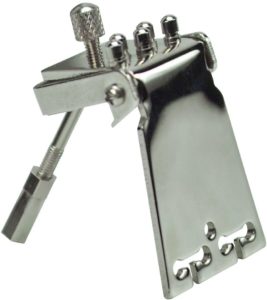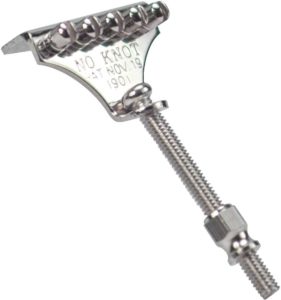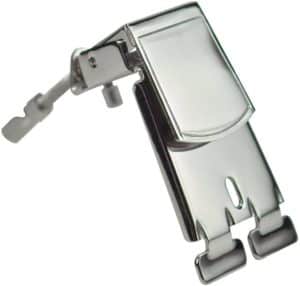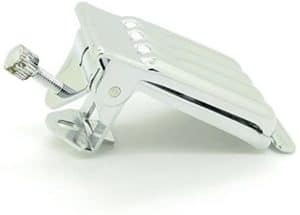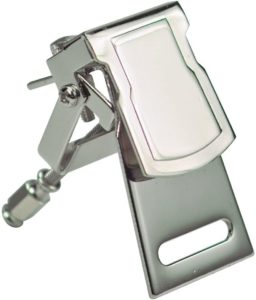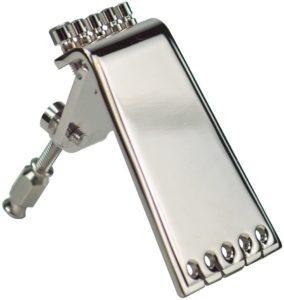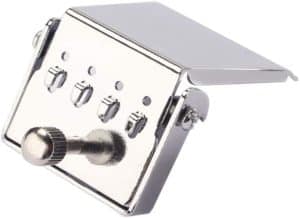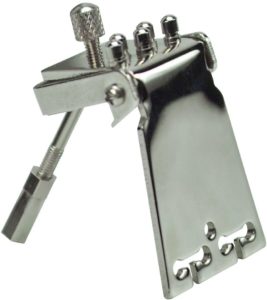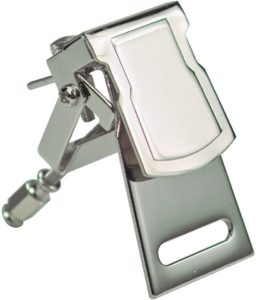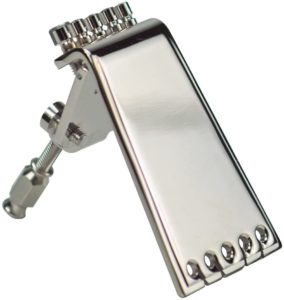Did you know that a good quality Banjo will always have an adjustable tailpiece – barring the extremely old models, such as the Deering Vega Old or maybe the Time Wonder which comes with a ‘No- Knot’ fixed and small tailpiece that provides a traditional look and sound? It is important to keep in mind that, the bet adjustable banjo tailpiece usually has no resonance of its own, which makes it a good option because it doesn’t ring and doesn’t interfere with the overall tone of the ring as well as the rim.
The reason a banjo tailpiece is a piece of very important equipment is because of its role in helping with the tone and volume of the banjo. Its main function is to help anchor the strings. Its second most important function is to put maximum pressure on the bridge so that the bridge is able to transmit sound right into the head of the banjo. Thus, if you’re on the lookout for the best banjo tailpiece, it is imperative that you understand its primary requirements.
How to set up the banjo tailpiece?
It is important to note that, you shouldn’t exert too much tension on the tailpiece. It should be tightened in a way that it rests firmly on the stretcher band of your banjo, in order to provide stability. The tip of the tailpiece, that is, where the strings can be seen coming off it, should be roughly around 3/16 inch up to a maximum of ¼ inches about its head. If by any chance it comes much lower, then it might lead to a muting of the banjo a little, and might also end up producing a brassy sound, to say the least.
What are the different types of banjo tailpieces?
Banjo tailpieces depend on whether you’ll be needing 4-strings, 5-strings, or 6-strings.
The top styles of banjo tailpieces are – Waverly, presto models, Kershner, straight line as well as the tailpieces which are specifically found on vintage banjos.
Best Banjo Tailpieces – Buying Guide
While there aren’t any specific factors you can look at when buying a banjo tailpiece because almost every banjo needs it, there are certain factors you should consider when selecting your banjo because based on that will you be buying the tailpiece, so read on.
Factors to consider when looking setup the best banjo tailpiece
If you happen to be a beginner when it comes to banjos, then it is necessary that you keep the following factors in mind, while fixing your banjo’s tailpiece, perfectly.
The few most important steps with regards to setting up a banjo are
- Its hardware check
- It’s head tension
- Its neck angle is also known as its action
- The tailpiece adjustment
- The bridge placement is also known as its intonation
- Its hardware check – In most banjos, the different elements are either bolted or clamped together. You can easily disassemble a banjo using a wrench or a screwdriver, or even both. This also allows you to ensure that you are able to change and replace most of the components just as easily. Thus, when you look to set up your banjo, it is imperative that you check – none of the pieces is coming loose. Ensure that both the neck bolt as well as coordinator bolts are tight. Ensure that the j-hook shoes are also tightened on the inside bit of the pot. Most importantly, make sure to check that the bolt which holds the tailpiece together, is tightened well.
- It’s head tension – It is very difficult to be absolutely sure as to the extent of tension you can put, to the head of the banjo to make it sound perfect. While most people believe that the tighter the tension, (a reasonable amount) the better it is, whereas the looser it gets, the worse it is. There is one scientific method of determining whether the head has enough tension or not – it is by using torque gauges that work to measure out each nut or makes use of a drum head tension gauge. The other end would be to tighten the spectrum until and unless it feels perfect.
- However, if you are looking for the easiest method available, then that would be the coin method. For this, you will be needing a 10-inch straight edge which is to fit in-between the head of your banjo as well as strings that are in front of the bridge. It is believed that if you are able to insert a quarter under the center of the straight edge, then you must be having the correct tension. If you are able to fit in a Nickle, then your head requires a little more tightening.
- S. – There are also those that believe the thickness of the Nickle provides them with the exact sound they want.
- Its neck angle (also known as its action) – Always ensure that you have checked the tension of the banjo’s head before plunging in to check the action or the string height. If you tighten it, then it will cause the overall effective height of the string in your banjo to increase. Remember to always measure the action at the last fret. Also, the action should be such that it feels comfortable when you are playing the banjo and there is no buzzing of the strings produced against each of the frets when the instrument is played.
- Its tailpiece adjustment – The tailpiece can usually be adjusted both up or down, depending on your requirement. You will have to adjust the distance between the head and to where the strings usually come in contact with the tailpiece, and that which changes the tension of the string downwards on the bridge. The lower it happens to be, the more tension will be produced, and that will eventually lead the banjo to produce a sound that is both louder as well as brighter. However, this adjustment is a completely personal preference. Vintage banjos usually require less tension
- Its bridge placement (also known as its intonation) –The final step in the banjo setup, would be to ensure that the bridge has been placed properly. For this, you will have to measure the distance from the nut right up to the middle of the 12th It is okay if your accuracy happens to be a little off the mark. Simply keep in mind the following two points, during bridge placement –
- In case the pitch of the harmonic note happens to be higher in comparison to the fretted note, then you will have to move the bridge a little closer to the nut.
- If in case the pitch of the harmonic note happens to be lower in comparison to the fretted note, then you will have to move the bridge further away from the nut.
Best Banjo Tailpieces Reviews
Now, having figured out how to set up our banjo in the correct manner, using accurate measurements and types of equipment, let us take a look at some of the best banjo tailpieces that are available in the market
The Golden Gate P-117 is an old Waverly styled banjo tailpiece that is made of nickel and is an ideal option to choose when looking for a tailpiece for your vintage banjo such as the 1920’s Ludwig or so. Some of its key features include
- It has a triple nickel-plated brass construction which provides excellent durability and also has a classic vintage look to it
- It has a thumbscrew adjusted string tension that allows you to explore a ton of different ranges for different tones and also ensures that you are able to get a quicker attack as well as maximum tone production.
- String changes can be done quickly and easily, thanks to its flip-top tailpiece cover which helps to eliminate unnecessary breakage of the strings
- It is an ideal buy if you’re on the lookout for a vintage repairing or restoring or even if you are looking to build a new setup
- It helps to accommodate strings that are loop ended
Another product from the house of Golden Gate, the P-115 No-Knot Style banjo tailpiece, similar to the old Waverly style tailpiece is made of nickel and would be an ideal choice for oldtimer open-back banjos. Some of its key features include
- It has a traditional design which is ideal for the turn-of-the-design century and is mostly used in old-timer open-back banjos
- It has a triple nickel-plated brass construction which provides excellent durability and also has a classic vintage look to it
- It has a no-frill non-adjustable design which is sure to last you a lifetime
- The string changes can be fast as well as easy when they are externally mounted and have rare facing string posts which helps to reduce as well as eliminate any form of string breakage
- It is an ideal buy if you’re on the lookout for a vintage repairing or restoring or even if you are looking to build a new setup
The Golden Gate P-118 old Presto Style Banjo Tailpiece like its contemporaries is made of nickel and would be an ideal choice for the 1930s triple nickel-plated brass construction look. Some of the key features of this banjo tailpiece are
- It helps to perfectly reproduce the design of the 1930s triple Nickle brass-plated construction
- It provides excellent durability as well as a truly authentic and vintage look
- Its design is without a hinge so as to provide maximum rigidity using the oval third-string hole as well as spacing guides to accommodate the other strings
- String changes can be done quickly and easily, thanks to its flip-top tailpiece cover which helps to eliminate unnecessary breakage of the strings
- It is an ideal buy if you’re on the lookout for a vintage repairing or restoring or even if you are looking to build a new setup
The Nickel Chrome Plated Bridge Tailpiece clamshell cover is ideal for a 5- stringed Banjo and weighs in a mere 70 gms. Some of its key features include
- It is extremely durable and is made of solid material which will last for years to come
- It has a spring action cover
- It comes in a chrome color
- It doesn’t require mounting screws and comes with an attachment nut as well as bolt
- It is nickel plated
- It is an ideal buy if you’re on the lookout for a vintage repairing or restoring or even if you are looking to build a new setup
- It has a Clamshell design
- The tailpiece is completely adjustable
The Golden Gate P – 110 Waverly Banjo Tailpiece weighs a mere 0.13 pounds and is opted for, by most of the domestic banjo makers. Some of its key features include
- Its dimensions are – 2.5 x 1.2 x 1.5 inches
- The Waverly Style Banjo Tailpiece is considered to be one of the most popular styles of banjo tailpiece bridge there is, and it is mostly opted for by every single domestic banjo maker
- It has a triple nickel steel plated construction, which often allows it to remain durable and also ensures that it has a vintage look to it
- It has a thumbscrew adjusted string tension which allows it to be used for a range of different tonal options, along with using it for a quicker attack as well as maximum tone production
- It allows for fast string changes and also comes with a flip-top tailpiece cover that allows eliminating any form of string breakage
- It is an ideal buy if you’re on the lookout for a vintage repairing or restoring or even if you are looking to build a new setup
- This is made in Japan
The Golden Gate P – 113 Kershner Banjo Tailpiece is made of nickel like all other tailpieces and has originated from the 1920s models – which were used for the Vega and Gibson banjo models. Some of its key features include
- The Kershner design had first originated in the 1920s and was used in Vega and Gibson banjos
- It provides a vintage look and also, it has a triple nickel-plated brass construction which makes it extremely durable
- It has a thumbscrew adjusted string tension which allows it to be used for a range of different tonal options, along with using it for a quicker attack as well as maximum tone production
- It allows for fast string changes and also comes with a flip-top tailpiece cover that allows eliminating any form of string breakage
- It is an ideal buy if you’re on the lookout for a vintage repairing or restoring or even if you are looking to build a new setup
- It weighs 3.2 ounces
- Its dimensions read – 3 x 1 x 1.5 inches
The Heavily Banjo Tailpiece comes in silver color and can easily act as a replacement tailpiece for a 4 string banjo. Since it is made of alloy, the chances of it breaking or getting damaged are minimum too. Some of its key features include
- It is 100% brand new and is made of high-quality premium material which makes it both easy to clean as well as repair
- It is extremely easy to set up, play as well as install.
- It is extremely stable, durable as well as flexible to use
- This tailpiece is ideal for those looking for a new build or to repair a vintage banjo or even if you are looking to restore an old banjo. It would be an ideal replacement for your broken or old banjo tailpiece.
- In this tailpiece, string changes are quite smooth, easy, and fast thanks to its flip-top tailpiece cover that ensures there is a complete elimination of string breakage
- It is made of high-grade alloy
- Its dimensions read – 5 x 4.1 x 3.8 cms
- It weighs 1.45 ounces
Conclusion
Looking to buy the best banjo tailpiece can be a tough task if you’re not completely sure of how to shortlist your choices. It depends on what kind of banjo you have, whether you’re looking to repair a vintage banjo, or if you’re looking to set up a new banjo and the like. You will also have to consider the number of strings your banjo has and the specific type of banjo you have.
Having said that, all the products we have mentioned above are some of the best banjo tailpiece available in the market currently and are suitable for different types of banjos, right from vintage ones to modern ones, so you will surely find something that your suit your specific banjo tailpiece requirements.
Frequently Asked Questions
-
How to adjust a banjo tailpiece?
Ans. To adjust a banjo tailpiece, you will have to adjust it using the screw which is placed at the back of the tailpiece. A tailpiece that is adjusted down closer towards the head will provide the banjo with a brighter and crisper sound, whereas one adjusted looser or away from the head will provide an opposite effect.
-
What is no knot tailpiece?
Ans. A no knot tailpiece is a specific type of Banjo tailpiece which was first designed around the beginning of the 20th century. It was designed to help solve the problem of tying a knot using gut strings which were previously being used to attach the tailpiece with the strings.
-
Does the tailpiece affect the tuning of a Banjo in any way?
Ans. The answer would be yes when asking whether the bridge changing the pitch of the head often referred to as the soundboard when pressure is applied. Thus, the more the head is tightened with the help of the bridge’s down pressure, the pitch is affected.
You can also check out Banjo pickup which is also a very important add-on to your instrument which helps in playing the banjo effectively.

Hi, I am William. I am a music enthusiast. I play the guitar and ukulele. I like to try out all instruments and review them, to help others make an informed decision. You must choose the right instrument to get that sweet sound you desire. When I am not on my instruments I will be found reading or cooking.

